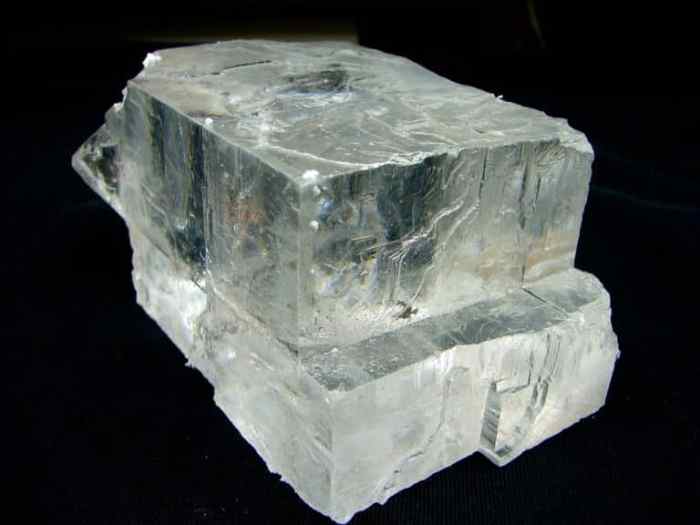Nonmetallic minerals like halite and gypsum have no industrial uses – Nonmetallic minerals like halite and gypsum, often overlooked for their industrial value, play a crucial role in various industries, shaping our daily lives in unexpected ways. From construction to agriculture, these minerals serve as essential components, highlighting their economic and practical significance.
This exploration delves into the industrial applications of halite and gypsum, uncovering their unique properties and how they contribute to diverse sectors. We will also examine the broader category of nonmetallic minerals, comparing their industrial value to metallic minerals and exploring their distinct characteristics.
Nonmetallic Minerals: Halite and Gypsum
Nonmetallic minerals, like halite (rock salt) and gypsum, have significant industrial applications. Halite is used in food preservation, water softening, and road deicing. Gypsum is utilized in the construction industry for drywall, plaster, and cement.
Industrial Uses of Halite
- Food preservation (table salt)
- Water softening
- Road deicing
- Chemical feedstock (chlorine and sodium hydroxide production)
Industrial Uses of Gypsum
- Drywall and plaster
- Cement
- Soil amendment
- Medical applications (casting and splinting)
Economic Significance
Halite and gypsum are economically important minerals due to their wide range of industrial uses. The global halite market is valued at over $10 billion, while the gypsum market exceeds $20 billion. These minerals support various industries, including food, construction, and manufacturing.
Nonmetallic Minerals and Industrial Value

Other Nonmetallic Minerals
- Limestone (calcium carbonate)
- Sandstone (silica)
- Phosphate (fertilizers)
- Potash (fertilizers)
- Talc (lubricants)
Industrial Applications
Nonmetallic minerals have diverse industrial applications, including:
- Construction materials (limestone, sandstone)
- Fertilizers (phosphate, potash)
- Lubricants (talc)
- Glass and ceramics (silica)
- Paper and paint (limestone)
Comparison to Metallic Minerals
Nonmetallic minerals differ from metallic minerals in their industrial value. Metallic minerals are typically more valuable due to their electrical conductivity and other properties. However, nonmetallic minerals are essential for various industries and contribute significantly to the global economy.
Properties of Nonmetallic Minerals

Halite and Gypsum Properties
Halite is a colorless or white mineral with a cubic crystal structure. It is highly soluble in water and has a salty taste. Gypsum is a white or colorless mineral with a monoclinic crystal structure. It is less soluble in water than halite and has a bitter taste.
Influence on Industrial Uses
The physical and chemical properties of halite and gypsum influence their industrial uses. Halite’s solubility and salty taste make it ideal for food preservation. Gypsum’s low solubility and bitter taste limit its use in food but make it suitable for construction materials.
General Characteristics
Nonmetallic minerals generally have low electrical conductivity, low density, and low hardness compared to metallic minerals. They are often brittle and have a non-metallic luster.
Alternative Materials and Substitutes: Nonmetallic Minerals Like Halite And Gypsum Have No Industrial Uses

Alternatives to Halite and Gypsum
- Sea salt (for food preservation)
- Potassium chloride (for water softening)
- Urea (for fertilizers)
- Anhydrite (for drywall)
Advantages and Disadvantages
Alternatives to halite and gypsum offer advantages and disadvantages. Sea salt is a natural alternative but may contain impurities. Potassium chloride is more expensive than halite but has a lower sodium content. Urea is a synthetic alternative that is less expensive but may require additional processing.
Technological Advancements
Technological advancements may impact the demand for nonmetallic minerals. The development of alternative materials and processes could reduce the need for traditional nonmetallic minerals.
Environmental Impact and Sustainability

Mining and Processing
Mining and processing nonmetallic minerals can have environmental impacts, including land disturbance, water pollution, and air pollution. Sustainable practices, such as responsible mining techniques and waste management, can minimize these impacts.
Sustainable Practices, Nonmetallic minerals like halite and gypsum have no industrial uses
Sustainable practices for nonmetallic mineral industries include:
- Minimizing waste and maximizing resource utilization
- Reducing energy consumption and greenhouse gas emissions
- Restoring mined land and mitigating water pollution
Innovative Technologies
Innovative technologies can reduce the environmental footprint of nonmetallic mineral industries. These technologies include:
- Improved mining techniques to minimize land disturbance
- Water recycling and wastewater treatment systems
- Alternative energy sources to reduce carbon emissions
Questions Often Asked
What are the major industrial uses of halite?
Halite, commonly known as rock salt, finds applications in food preservation, water softening, and deicing, among others.
How does gypsum contribute to the construction industry?
Gypsum is primarily used in the production of drywall, plaster, and cement, contributing to the construction of buildings and infrastructure.
What are some alternative materials that can replace nonmetallic minerals?
Synthetic polymers and composites can sometimes serve as alternatives to nonmetallic minerals, offering similar properties and reduced environmental impact.
